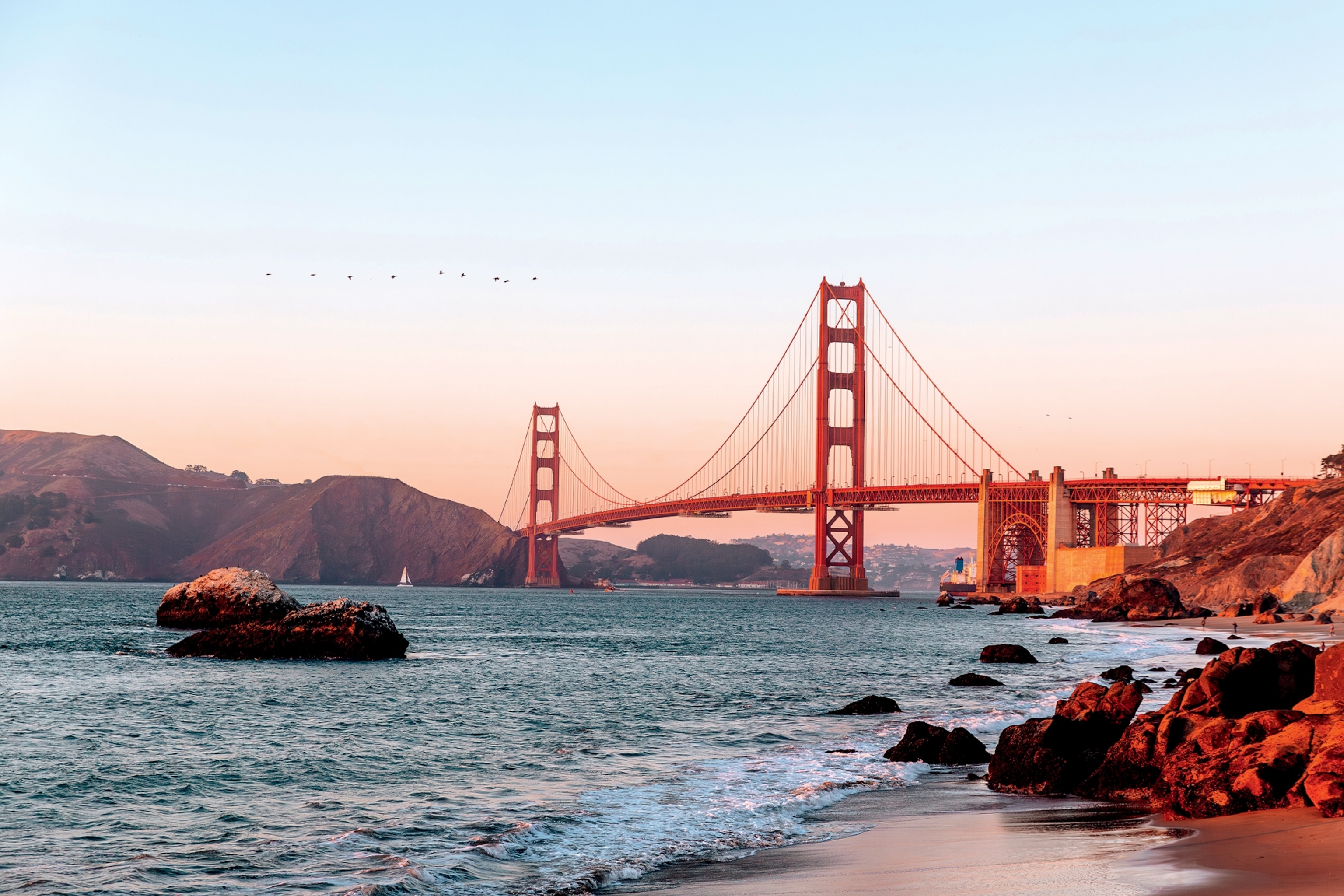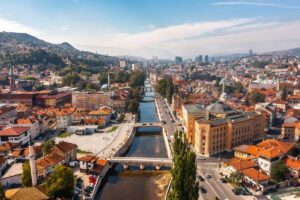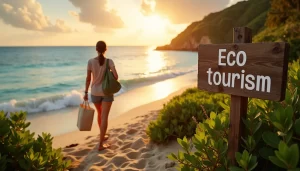What it’s like to travel along the West Coast on a train
6 min readThis article was produced by National Geographic Traveller (UK).
North of Los Angeles, the old tracks speed us out of Star City. The high-rises fade away into thickly vegetated canyons and creeks, the San Fernando Valley and Burbank glinting in blazing sun. In the train observation car — a living room on rails — we seem to be moving almost silently. But I’m aware of a dizzying vision of America ahead, feeling what poet Walt Whitman perhaps sensed when praising this way of travel. ‘Type of the modern! Emblem of motion and power! Pulse of the continent!’ he wrote in To a Locomotive in Winter, his ode to US train travel. There are probably several interpretations of this — but, to me, it seems to mean that while American freedom came from the revolution, it was the railroads that laid the foundations for the American dream.
Operated by Amtrak, the Coast Starlight has been running from Los Angeles to Seattle in its present form for 50 years. Rail buffs may ride the route for its full 35-hour, 1,377-mile duration, but mine is the journey of the part-time trainspotter. My destination is northern California and Sacramento — one of the most historic railroad cities in the US.
The first long-distance locomotive on the Pacific coast was called the Coast Daylight and it commenced service in 1937 — yet rolled only as far north as San Francisco. The pre-war streamliner that ran the route was described by the local press as the ‘most beautiful passenger train in the world’. Its rush, roar and shrill steam whistle are now footnotes in railroad history. But I remain convinced there’s no better way to see California — if not the whole of the US — than from a train carriage window, while the silver-liveried engine speeds beneath big skies of bright, cobalt blue.
By the time we reach Santa Barbara, the California of the mind’s eye has arrived — albeit in fleeting glimpses. A heron takes flight over rippling Pacific waves. A lone surfer channels the spirit of surf rock bands of the 1960s on Arroyo Quemada Beach. Seaweed swirls in the shallows. Hundreds of pelicans pose. On a good day, a humpback whale might breach skywards.
Offshore, in the Southern California Bight, lie the islands of San Miguel, Santa Rosa and Santa Cruz — their names reflecting the whims of British explorer George Vancouver, who had a Spanish map in his pocket while exploring the coast in the late 18th century. Their original inhabitants were the Indigenous Chumash people and the landscapes are as wild now as they were thousands of years ago. The beach-curled islands can be reached only by concessionaire boats, then explored on foot or by kayak. The most significant benefit, perhaps, is keeping all those who visit in close contact with the untouched nature left behind by the Native Americans.
The train trundles on. Ours is now a journey north towards San Luis Obispo, whose ‘SLO CAL’ label evokes both the county’s initials and the area’s laid-back lifestyle. We sneak onto a part of the coast where roads don’t reach. The train hugs the beach, its tracks almost touching the shore, then skirts through dunes matted with swaying wild rye and purple needlegrass. A bridge carries us across an estuary marbled with sand and I wish for an unscheduled stop, so I can leap into the sparkling ocean.
“Just look at those colours,” says a fellow passenger. “I should have brought some popcorn,” adds her companion. This deserted stretch is part of America that people rarely see.
Another highlight is the California Coastal National Monument, a stretch of coastline on which bluffs play peekaboo with the sea and oceanfront mansions try to outmuscle each other for beach space. The train waltzes through awestruck coastal villages, like a celebrity on the red carpet. In a country dominated by trucks and turnpikes, trains are still such a novelty that, as the towns get smaller, the waves from wide-eyed children and families get more committed. I feel transported to another age.
Away from the scenery, the Coast Starlight is a living community of rituals and shared stories, with staff and passengers coming together in near-communion. Among them is Patrick, who calls over the loudspeaker that the dining car is open for lunch. He rides the rails all the way to Seattle and back once a week and admits the odyssey is not without its challenges. One fear, he tells me, is passengers missing the journey’s most memorable parts because they’ve been lulled to sleep by the cradle-rock of the carriages.
“Don’t miss my beautiful Cascades,” says Patrick, handing me a menu as he rhapsodises about the mountain range that stretches south from British Columbia in a glorious vision of serrated peaks. “California’s beaches are great, sure, but those forests, volcanoes and mountains? Wow.”
I decide it’s best not to mention my pre-lunch nap, and focus instead on my bacon chilli bowl. I missed the olive groves and striped vineyards of Paso Robles, and my introduction to Central California — north of San Diego, south of Frisco — was more a blurry, broken dream.

The first long-distance locomotive on the Pacific coast was called the Coast Daylight, but it only went as far north as San Francisco.
Photograph by Alexandr Spatari, Getty Images
Solar farms, steel and San Francisco
The colours shift the closer we travel to San Francisco Bay. Leaving the winelands behind, we begin to wind through the dusty brown hills and fruit farms of Monterey County, before creeping along the Salinas Valley. People know this area because its most famous resident, John Steinbeck, wrote of the valley’s no-fuss ranches of mules and migrant workers in Of Mice and Men. But I see a very different vision of America spooling past. Sprawling solar farms bring to mind the desert sci-fi scenes of the blockbuster film Dune. Fields are filled with oil wells whose pumpjacks tip back and forth like toy drinking birds. Even with the train’s engine going, I can hear bushtits warbling on wires and cicadas coming out to score the dusk. Around me, the air smells of fresh pizza — we’ve pulled into Salinas and a delivery ordered by a passenger is passed Frisbee-style into the carriage.
Later, San Jose is aglow by sunset. No one does cities like America and the national obsession with steel and construction rewards those of us on the Coast Starlight as we swing slowly north around San Francisco Bay. In quick succession, San Jose bleeds into Oakland in twilight, with San Francisco a beacon of crackling light across the water. I find myself taking picture after picture of the reflections as we ride.
Just before midnight, the train makes its last stop of my journey at Sacramento Valley Station, the terminus of America’s first transcontinental railroad in 1863. I gaze at a sky blanketed in stars, waiting for the moment the train departs: away from Sacramento’s Old Town, with its boardwalk saloons and historic state railroad museum, into the dark, and towards the end of the line. For now, the night will rob those aboard of views of northern California, but the sun will rise over Mount Shasta before the train reaches Oregon, Washington and the Cascades.
Walking from the depot, Sacramento is asleep. I wonder if the railroad barons who raised this gold-rush-era city during its mid-18th-century heyday might have felt the same about the journey as I do now: that railroad travel in America is to be cherished, not forgotten, as it has been by so many millions. Much of the United States is preserved along these lines. I love what I have seen — the history, the spectacle, the colour — and, tomorrow, others might find themselves inspired to climb aboard as I have. I hope so, anyway.
How to do it
To subscribe to National Geographic Traveller (UK) magazine click here. (Available in select countries only).
Discover more from Slow Travel News
Subscribe to get the latest posts sent to your email.



